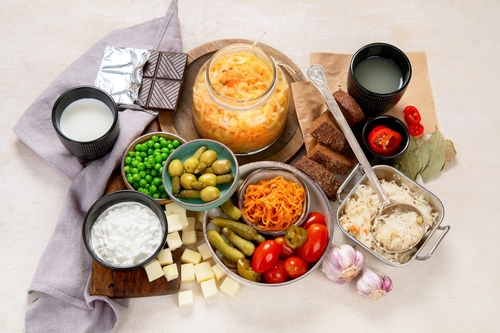More Than Just Buzzwords
In the world of gut health, the words probiotic and prebiotic are everywhere—from yogurt cups to supplement labels. But while they sound similar, they serve very different (yet equally important) roles in maintaining a balanced digestive system. Understanding what each one does—and how they work together—can help you make more informed choices for supporting your microbiome, digestion, and overall well-being.
Ad Banner #1
— Placeholder for the first advertisement —
What Are Probiotics, Really?
Probiotics are live, beneficial microorganisms—mostly strains of bacteria and some yeasts—that help populate your gut with friendly microbes. These organisms naturally exist in the digestive tract, but certain lifestyle factors like stress, illness, medications (especially antibiotics), and poor diet can throw their balance off. Adding probiotics through food or supplements may help replenish your internal supply and support smoother digestion.
You’ll find probiotics in foods that have undergone natural fermentation, such as:
-
Yogurt with live cultures
-
Kefir (fermented milk drink)
-
Kimchi and sauerkraut
-
Miso and tempeh
-
Kombucha
These foods don’t just taste tangy—they contain living cultures that, when consumed regularly, may aid in nutrient absorption, support immune function, and help maintain regular bowel movements. Different strains (like Lactobacillus or Bifidobacterium) offer different benefits, so variety is often key.
So Then, What Are Prebiotics?
If probiotics are the seeds, prebiotics are the soil. They’re a specific type of plant-based fiber the body can’t digest—but your gut bacteria can. Prebiotics serve as fuel for the probiotics, helping them grow, thrive, and do their job more effectively.
Naturally prebiotic-rich foods include:
-
Garlic
-
Onions
-
Leeks
-
Asparagus
-
Bananas (especially when slightly green)
-
Oats and barley
-
Jerusalem artichokes
-
Chicory root
Prebiotics aren’t live organisms, but they play an equally essential role by feeding and strengthening the good bacteria already in your gut. Without prebiotics, probiotics can struggle to survive long-term in the digestive environment.
Why the Synergy Between Them Matters
Probiotics and prebiotics are most powerful when they work together. This combination is often referred to as a synbiotic relationship. Think of it like tending a garden: probiotics are the seeds, prebiotics are the compost, and together they create a vibrant, growing ecosystem.
This synergy is crucial for:
-
Microbial balance: Prebiotics help probiotics colonize and crowd out harmful microbes.
-
Nutrient production: Together, they help create short-chain fatty acids (like butyrate), which can strengthen the gut lining and reduce inflammation.
-
Improved digestion: A nourished microbiome supports the breakdown of food, reduces bloating, and may ease symptoms like constipation or irregularity.
-
Immune health: Over 70% of immune cells are located in the gut, and a well-fed microbiome helps keep immune responses balanced.
-
Mood and brain health: Through the gut-brain axis, beneficial bacteria may even influence mood regulation and stress response.
Eating foods rich in both probiotics and prebiotics throughout the day—like pairing yogurt with sliced banana or enjoying stir-fried garlic vegetables with tempeh—helps support this synergy naturally.
Ad Banner #2
— Placeholder for the second advertisement —
Building a Gut-Friendly Routine
You don’t need supplements to experience the benefits of probiotics and prebiotics. Focus on a diverse, plant-forward diet that includes both types of support:
-
Start your day with kefir and oats topped with berries (probiotic + prebiotic).
-
Add fermented veggies to sandwiches, grain bowls, or soups.
-
Snack on sliced apple with almond butter and a sprinkle of cinnamon.
-
Cook with garlic, onions, and leeks regularly to keep prebiotics on your plate.
-
Hydrate well—water helps fiber move through the gut and makes it easier for bacteria to thrive.
Introducing these foods slowly is key—especially if your current diet is low in fiber or fermented foods. A gradual approach reduces the chance of bloating or discomfort as your microbiome adjusts.
When to Consider Extra Support
While food is the most sustainable way to build a strong microbiome, some people may benefit from high-quality supplements, especially after antibiotics or during periods of digestive distress. Choosing a probiotic that includes multiple strains and pairing it with prebiotic-rich foods can help replicate the natural balance found in a healthy gut.
If symptoms like gas, bloating, constipation, or food sensitivities persist, it may be time to work with a practitioner who understands gut health to explore deeper imbalances, like dysbiosis or leaky gut.
A Balanced Gut Starts with Balance on Your Plate
The difference between probiotics and prebiotics is simple—but the impact they can have together is profound. By feeding your gut a steady supply of both, you create an environment where beneficial microbes can thrive, supporting digestion, immune function, and even emotional well-being.
You don’t need extreme diets or complicated routines to build a healthier microbiome—just consistent, small steps rooted in whole foods and gentle awareness of what your body needs.



























